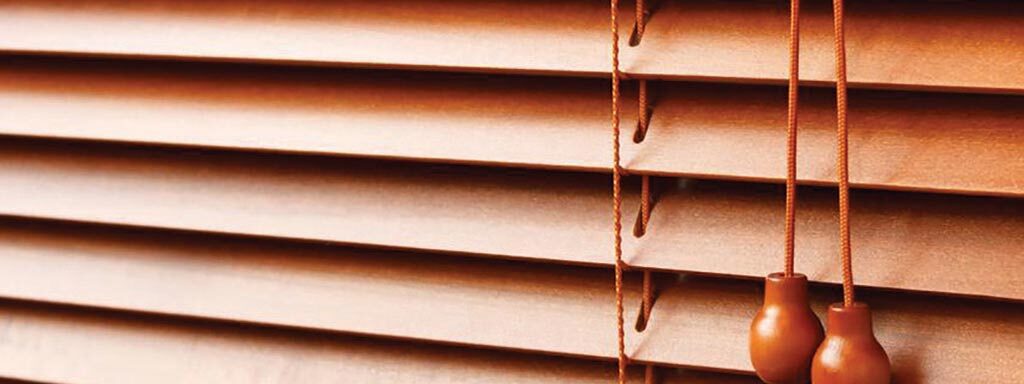BLINDS
5 Different Types of Blinds and Their Features
1. Horizontal Blinds
Horizontal blinds are also called venetian blinds. They’re made with horizontal slats that hang from a headrail by a cord. The headrail is a metal box that makes up the top part of the blinds. It houses the mechanisms that open and close the blinds. Wood and faux wood venetians often come with a decorative valance that’s the same colour as the slats and covers the headrail.
Pros: Horizontal blinds offer the best light control of any blind and are available in a range of styles, colours and slat widths.
Cons: While these blinds can block up to 95% of the light, they are not blackout blinds and won’t provide total darkness in a bedroom. Also, this is one of the more difficult types of blinds to clean because you have to wipe down each slat individually.
2. Roller Blinds
Roller blinds, also called roller shades, are made from a single panel of fabric that rolls down from a top bar. They also feature a weighted bottom bar that ensures the blind doesn’t blow around when it’s closed.
Because these blinds are made of fabric, they’re available in a lot of colour options and in whimsical prints. You can find roller blinds made from blackout fabric, light-filtering voile fabrics and two-layer day-and-night fabrics.
Pros: This window treatment offers lots of styling options, from colours and prints to different fabrics. You can choose between blackout or light-filtering fabrics, and many roller blinds wipe clean, making them easy to care for.
Cons: Even day-and-night roller blinds don’t offer as much light control as horizontal blinds because you can’t angle them to direct light around your room.
3. Roman Blinds
Roman blinds, or roman shades, are one of the most luxurious window coverings. They’re made from decorative fabric with horizontal stiffener rods sewn into the back in several places. The stiffener rods allow the blinds to fold neatly up toward the top of the window when opened. When closed, these blinds lay flat as one smooth piece of fabric.
This elegant window treatment is available in a variety of fabrics, from a faux silk to a rustic weave. You can also find beautiful colours and designer prints. There are multiple fabric linings to choose from, including light-filtering, blackout and thermal linings. In winter, a thermal lining can increase the energy efficiency of your windows and reduce your electric bill.
Pros: These blinds look expensive, but if you opt for a thermal lining, they can actually save you money in the long run. They’re also endlessly customisable since they come in a variety of fabrics, colours, prints and linings.
Cons: Roman blinds don’t offer a lot of light control — your only choice will be to open or close the blinds. This window treatment also requires a bigger upfront investment than many of the other blinds on this list, and depending on the fabric you choose, it can be harder to care for. Many fabrics are spot clean only.
4. Perfect Fit Blinds
Perfect Fit Blinds are actually available in many different types of blinds. The one thing they have in common: They attach directly to your window or door, not your window frame. They also sit flush against the glass. Even when you open or close your window or door, these blinds remain flat against the glass from top to bottom — with no dangling or banging about. This makes Perfect Fit blinds a popular choice for patio doors or windows that tilt open.
Pros: Perfect Fit blinds won’t bang about when you open and close your patio doors, and they won’t dangle from windows that tilt to open. They’re available in a few different types of blinds and with different lining and light control options.
Cons: If you opt for venetian blinds, you won’t get total room darkening like you will with honeycomb blinds. But if you opt for honeycomb blinds, you won’t be able to angle and direct the light into your room.
5. Vertical Blinds
Vertical blinds are made from vertical vanes rather than horizontal slats. The vanes are weighted and linked together at the bottom to keep them in position. They hang from a headrail and slide open to the left or right rather than opening from the bottom to the top of the window like the other types of blinds on this list.
Similar to horizontal blinds, vertical blinds allow you to angle the vanes and direct the light around your room. Instead of directing the light up or down, these blinds will direct the light toward the left or right of the room.
Pros: This window covering provides exceptional light control, giving you the ability to direct light around your room and enjoy total darkness with a blackout lining. It’s also the best option for large windows with a width of up to 400 centimetres.
Cons: Vertical blinds can be difficult to clean because you’ll have to wipe down each vane individually.

